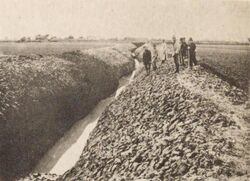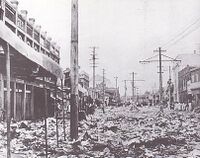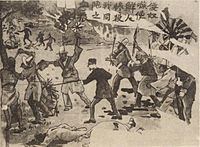Religion:Wanpaoshan Incident
The Wanpaoshan Incident (万宝山事件 Manpōzan jiken, Pinyin: Wànbǎoshān Shìjiàn) was a minor dispute between Chinese and Korean farmers which occurred on 1 July 1931, before the Mukden Incident.
Background
Wanpaoshan was a small village some 18 miles north of Changchun, in Manchuria, in a low marshy area alongside the Itung River. A group of ethnic Koreans (who were regarded at the time as subjects of the Japanese Empire) subleased a large tract of land from a local Chinese broker and prepared to irrigate by digging a ditch several kilometers long, extending from the Itung River across a tract of land not included in their lease and occupied by local Chinese farmers.
After a considerable length of the ditch had been dug, the Chinese farmers protested to the Wanpaoshan local authorities, who dispatched police and ordered the Koreans to cease construction at once and leave the area. The Imperial Japanese Consul based at Changchun responded by sending Japanese consular police to protect the Koreans, and both Japanese and Chinese authorities in Changchun agreed to a joint investigation.
Incident
However, before the joint investigation could be launched, a party of 400 Chinese farmers whose lands were cut by the irrigation ditch, armed with agricultural implements, pikes and handmade guns, drove the Koreans away and filled in much of the ditch. The Japanese consular police took a shooting stance to disperse the mob and to protect the Korean farmers. Both sides stared at each other for about an hour. The Chinese farmers withdrew, and the Japanese police remained on the spot until the Koreans completed the ditch and a dam across the Itung River. Japanese police officers and Koreans were not injured, but several Chinese were injured. Several Chinese were captured, but were brought back by Chinese public security officials.[1]
Anti-Chinese riots in Korea
Far more serious than the minor affair between farmers in Manchuria was the public reaction once highly sensationalized accounts of the conflict were published in Japanese and Korean newspapers. A series of anti-Chinese riots erupted throughout Korea, starting at Incheon on July 3 and spreading rapidly to other cities. The Chinese alleged that 146 people were killed, 546 wounded, and considerable properties were destroyed. The worst of the rioting occurred in Pyongyang on July 5. The Chinese further alleged that Japanese authorities in Korea did not take adequate steps to protect the lives and property of Chinese residents, and blamed the authorities for allowing inflammatory accounts to be published. The Japanese countered that the riots were a spontaneous outburst that was suppressed as soon as possible and offered compensation for the families of the dead.
Response by Chinese
In response to the anti-Chinese rioting by Koreans, anti-Korean riots by Chinese erupted all over China and the hatred of Koreans by the Chinese increased dramatically. It has been reported by the New York Times that in Jilin alone, Chinese rioters massacred 10,000 Koreans in retaliation and burnt or looted Korean houses all over the province. Another anti-Korean riot in Supingkai resulted in the deaths of another 300 Koreans.[2]
The public backlash from the riots also led to a Chinese boycott of Japanese-made products from May 1931.[3]
Consequences
Negotiations continued between the Japanese and the Chinese authories to resolve the situation. The Chinese maintained that the Koreans had no right to reside and lease land outside of Gando District, per the terms of the Gando Convention. The Japanese, on the other hand, insisted that Koreans, as Japanese subjects, had the same rights of residing and leasing land throughout South Manchuria as other Japanese. They also held that the Koreans had undertaken their project in good faith and blamed any irregularities on the Chinese broker who arranged the lease. The Japanese eventually withdrew their consular police from Wanpaoshan, but the Koreans remained.
A complete solution of the Wanpaoshan affair had not been reached by September 1931.
References
- ↑ 苦難与闘争十四年. 上巻. 中国大百科全書出版社. July 1995. pp. 112.
- ↑ Hyun Ok Park (1994). Materializing Nation and Gender: Peasant Mobilization in Northeast China from 1911 to 1945. p. 137. https://books.google.com/books?id=VlxMAQAAMAAJ&q=10,000+koreans+massacred+in+jilin+chinese&dq=10,000+koreans+massacred+in+jilin+chinese&hl=en&sa=X&ved=0ahUKEwj6qviz0JjRAhWBM48KHVVWCMMQ6AEIJjAC.
- ↑ Memorandum. 2. Institute of Pacific Relations, American Council. March 16, 1933. pp. 1–3.
Further reading
- Wang, Ching-Chun. Manchuria at the Crossroads. Annals of the American Academy of Political and Social Science, Vol. 168, American Policy in the Pacific (Jul., 1933), pp. 64-77
- Invasion & Occupation of Manchuria




